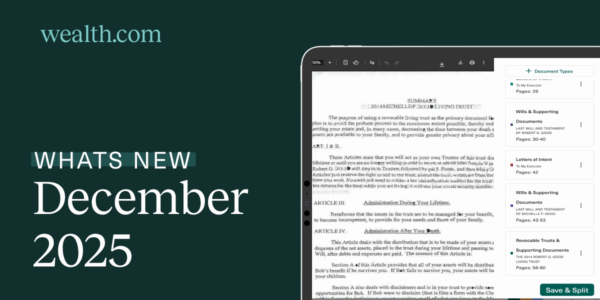Financial advisors who aren’t helping clients with estate planning may be missing key opportunities to align wealth with values, reduce taxes, and protect loved ones. Too often, advisors overlook tax and planning strategies that can deepen relationships and distinguish their approach.
While advisors are importantly focused on investment management and related tax strategies, estate planning presents its own unique opportunities to optimize clients’ taxes and wealth transfers. Here are ten tax-focused estate planning strategies to help you guide better conversations, strengthen relationships, and set yourself apart.
1. Gifting Appreciated Assets Can Beat Giving Cash
Gifting during life can be a powerful wealth transfer tool. Instead of giving cash, clients should consider gifting highly appreciated assets—like stocks—which allows them to avoid capital gains while transferring the full market value to the recipient. It’s a strategy that removes built-in gains from the client’s estate while benefiting someone they care about.
This is especially effective for gifts to family members or other recipients in lower tax brackets, who may owe little—or nothing—in capital gains tax if and when they sell the asset.
If the asset is gifted to a qualified charity, the charity typically won’t pay any capital gains at all, and your client may be able to deduct the full fair market value.
One caveat: recipients don’t receive a step-up in cost basis, as they would with inherited assets. Also, if the recipient is a minor, Kiddie Tax rules may apply. Recipients should also understand they may still owe capital gains tax when they decide to sell the asset.
2. Why the Step-Up in Basis Can Be Valuable
While gifting highly appreciated assets during lifetime can be powerful, don’t overlook the step-up in cost basis for inherited assets. When heirs inherit appreciated assets, capital gains taxes can be minimized or eliminated because the cost basis is reset to the fair market value.
This strategy is most effective for clients whose estates fall under the federal exemption limit ($13.99 for individuals as of 2025). And it’s most valuable for low-basis assets that are held long-term with the potential for appreciation, such as stocks or real estate.
In community property states, the surviving spouse may receive a full step-up in basis on both their share and the decedent’s share of their community property. This allows them to sell appreciated assets with little to no capital gains tax. In common law states, however, this treatment typically does not apply.
Clients who still want to gift—but hold assets that may appreciate further or can’t be easily transferred, like a primary residence—might consider using cash or lower-growth assets instead.
Though still in place, the step-up has been revisited in past tax reform proposals and could change in the future.
3. Irrevocable Trusts Can Shift Income and Shrink Estates
Irrevocable trusts are often used for wealth transfer, but they can also be strategic for income tax planning. Shifting income-producing assets into an irrevocable trust can reduce a client’s taxable estate and allow the income to be taxed to beneficiaries in lower brackets—depending on how the trust is structured.
Irrevocable trusts remove assets from the estate, reducing estate tax exposure and maximizing what can be passed on. But when structured as nongrantor trusts, they can also create income tax advantages by distributing income to beneficiaries who may be in lower tax brackets than the client.
This can be especially effective for clients with income-generating assets and a goal of sharing wealth with children or grandchildren. When income is distributed from the trust, it carries out taxable income—known as distributable net income (DNI)—which is then taxed at the beneficiary’s individual rate. If the beneficiary is in a lower bracket, overall family tax liability can be reduced.
Some clients may take a different approach and use grantor trusts intentionally, paying the income tax themselves so the trust assets can grow outside the estate, undiminished by tax liabilities. While grantor trusts are often used to freeze values and allow continued tax payment by the client, nongrantor trusts shift income—and the tax burden—to the beneficiaries.
As their advisor, you can help identify assets that are well-suited for trust ownership—such as rental properties, investment portfolios, or closely held businesses—and work with an estate attorney to ensure the structure and distribution terms align with the client’s long-term goals.
It’s important to keep in mind that trusts reach the top income tax bracket quickly—usually faster than individuals—especially if income is retained, so thoughtful distribution planning is key. And because irrevocable trusts typically can’t be altered once created, clients should be sure the strategy aligns with both their financial and family goals.
4. State Estate Taxes Still Matter, Even if the Federal Exemption Is High
While the current federal estate tax exemption is generous—$13.99 million for individuals in 2025—many states have much lower thresholds. Over a dozen states may still impose estate or inheritance taxes even if your client’s estate doesn’t owe federal taxes.
State estate tax rates can range from 10% to 16%, and are applied to the value of the estate that’s above the exemption amount. For example, Massachusetts has a $2 million exemption rate; Oregon has a $1 million exemption limit; and New York is about $6.94 million—all significantly lower than the federal threshold.
Many states also don’t allow portability, meaning that a surviving spouse may lose the unused exemption—$27.98 million for couples in 2025—without proactive planning. Furthermore, some states don’t index their exemptions for inflation, meaning more families may be exposed to state estate taxes over time.
Finally, some states still have inheritance taxes based on who inherits, not just the state size. For example, while New Jersey no longer has a state estate tax, inheritance taxes may still apply to beneficiaries that are not lineal heirs—meaning siblings, nieces, nephews, and cousins.
Advisors have the opportunity to help clients identify potential state estate tax exposure early, based on where they live, their asset location, and family structure. If your client is planning a move, you can help advise if it could impact taxes their estate may owe, or impacts it could have on wealth transfer plans.
Potential strategies for minimizing state estate tax exposure include lifetime gifting, charitable giving, trust planning, or moving to a state that has no estate tax. However, each strategy should be explored on a case-by-case basis, and with an attorney.
Changing residency to avoid state estate tax isn’t always straightforward and could be challenged by the state the client is leaving. Advisors should be aware of how domicile is determined—and help clients document and establish their new state residency appropriately.
Clients with property in multiple states may still face estate tax exposure in more than one jurisdiction. These situations require careful coordination, ideally involving attorneys familiar with the laws in each state where the client owns real estate or significant assets.
5. Annual Gifting Isn’t Just for the Wealthy
As of 2025, the annual gift tax exclusion lets your clients give up to $19,000 per person without triggering gift tax or filing requirements. There’s no limit on the number of recipients, meaning clients can give $19K to each child, grandchild, or other individual annually. Married couples can combine their exclusions to give $38,000 per recipient when gift-splitting.
These gifts don’t reduce the client’s lifetime exemption and don’t trigger gift tax or filing if within the annual limit. That’s why annual gifts can be a simple way to move wealth out of their estate gradually, even for clients that aren’t facing potential estate tax exposure.
This strategy can also be useful for funding 529 plans, custodial accounts, down payments on property, investing in family businesses, or just supporting heirs directly. And it can be especially powerful when it’s used consistently year after year as part of a wealth transfer plan.
You can help identify when an annual gifting strategy is useful—such as funding a grandchild’s 529 plan—and guide clients in tracking multi-year gifts. You can also help coordinate giving among family members to stay within the limits.
It is important to note that if a client does exceed the $19K annual limit, they will be required to file an IRS Form 709 and the amount over the limit will count against their lifetime exemption.
However, when used properly it’s one of the most flexible tools for tax-efficient giving while also having minimal requirements, such as tax filing or trust creation.
Used consistently, annual gifting is one of the simplest ways to move wealth tax-efficiently with minimal administrative burden.
6. How Roth Conversions Can Be an Estate Planning Tool
Roth conversions are typically viewed as a tax income strategy, but they can also support estate planning goals. Converting a traditional IRA to a Roth means the client pays income tax now, which can reduce their taxable estate.
Once converted, Roth IRAs continue to grow tax-free and can then be passed to heirs without any income tax liability. Non-spouse beneficiaries must withdraw the full Roth IRA within 10 years under the SECURE Act—but unlike traditional IRAs, annual RMDs aren’t required during that period.
This conversion strategy can be especially efficient if your clients have low-income years or during market downturns, when account values tend to be temporarily lower. It’s especially effective for clients who don’t need the IRA for income and want to prioritize a tax-free legacy. Conversions may also reduce future Medicare IRMAA surcharges or limit Social Security taxation for your client by lowering future RMDs.
Plus, this strategy can help mitigate the impact of the SECURE Act which eliminated the lifetime-stretch rule for inherited IRAs for most heirs.
You can help your clients by modeling partial conversions over several years to stay within target tax brackets to maximize long-term efficiency.
7. Don’t Forget Income Tax Planning for Beneficiaries
Estate planning matters just as much for heirs as for those passing down wealth. Advisors can support both sides to help clients structure more tax-efficient strategies and help heirs manage the income tax impact when they receive assets. Advisors play a key role in helping clients—and their heirs—understand the tax consequences of inherited accounts.
For example, the SECURE Act eliminated the stretch rule for inherited IRAs—where an heir could stretch withdrawals over their lifetime—requiring full withdrawals within 10 years. Inherited traditional IRAs are also fully taxable as ordinary income, and large balances can easily push heirs into higher tax brackets.
Inherited Roth IRAs must also be emptied within 10 years but withdrawals are tax-free, and don’t have annual RMDs.
You should work with clients to create withdrawal strategies that spread taxable income across years and to help avoid last-minute tax increases. For taxable accounts, you can review the cost basis and help your clients plan tax-efficient liquidation strategies.
If your client has a trust that inherited retirement accounts, you should also review them carefully to avoid unfavorable tax treatment under post-SECURE Act rules.
Clients often underestimate how long taxes can impact heirs, while heirs may not fully understand their potential tax consequences when receiving an inheritance. Advisors help clients and heirs navigate what’s often an overlooked—and heavily taxed—part of the planning process.
8. Portability Isn’t Automatic—File That 706
Portability allows a surviving spouse to inherit the deceased spouse’s unused federal estate tax exemption. This means the surviving spouse could preserve up to $27.98 million in total exemption, as of 2025.
Portability is particularly important when one spouse owns most of the couple’s assets, or when the surviving spouse may remarry and risk losing the unused exemption.
But portability isn’t automatic. The estate must file a Form 706 (the federal estate tax return) even if it doesn’t need to pay an estate tax. This is often an overlooked step because many believe it only applies to taxable estates. As their advisor, this is where you can step in to ensure they don’t lose millions in exemptions.
The good news is that the IRS now allows up to five years to file a late Form 706. However, this window should not be taken for granted and filing as soon as possible is best practice. Filing Form 706 documents asset values at the time of transfer, helping establish the new cost basis and avoid disputes over valuation down the line.
As an advisor, you can flag portability as a critical action item for newly widowed clients, even if no estate tax appears likely. You can also coordinate with estate attorneys and tax professionals, as needed, to ensure the Form 706 is filed correctly and on time.
Filing during a difficult time may feel secondary—but it can be one of the most impactful actions for preserving wealth transfer opportunities.
9. Intra-Family Loans Offer Low-Rate Leverage
An intra-family loan lets a client transfer wealth without using their lifetime exemption or triggering gift tax, as long as the loan charges interest at or above the IRS’s Applicable Federal Rate (AFR).
Each month, the IRS publishes three AFRs—short-, mid-, and long-term—based on the duration of the loan. These rates are often well below market rates, creating an advantage for long-term family wealth transfer planning.
This can allow your clients to lend to their children, grandchildren, or even to trusts to fund a home purchase, invest in a business, or contribute to an investment portfolio. If the borrowed funds grow faster than the owed interest, the excess growth remains with the borrower (e.g. the child) and not within the client’s estate. This strategy works best when the borrowed funds are expected to grow faster than the interest owed.
Plus, as long as the loan is documented properly, it avoids gift tax consequences. To do so, the loan should include a written promissory note, charge at least the AFR rate, and show a clear record of payments.
Clients can also forgive payments over time using the annual gift tax exclusion, gradually converting the loan into a tax-efficient gift.
This strategy can be a flexible way to support family goals while reducing the size of the estate without triggering immediate taxes. However, do note that they must be properly documented and treated like real loans. Otherwise, the IRS may reclassify them as gifts. Clients also need to report interest income and be prepared for the possibility of default if the borrower can’t repay.
You can help clients structure loan terms, ensure proper documentation, track payments, and understand whether this strategy aligns with their broader planning goals.
10. Donor-Advised Funds Let Clients Front-Load Charitable Giving
Donor-Advised Funds (DAFs) allow clients to make a large charitable contribution in a single year, and then decide where to grant those funds over time. This can be beneficial because the client gets an immediate income tax deduction for the full amount contributed, even if the funds are distributed to charities later.
Additionally, assets inside the DAF—which can be appreciated securities or stock, in addition to cash—can be invested and grow tax-free before they’re distributed. Gifting these appreciated assets to a DAF can avoid capital gains tax while maximizing the charitable deduction.
DAFs work especially well when clients want to front-load—or ‘bunch’—charitable giving in a high-income year while distributing grants over time.
DAFs are easy to set up, require no private foundation filings, and are widely available through custodians and nonprofits. You can help clients choose the right assets, time the deduction effectively, and ensure their giving aligns with both tax planning and long-term legacy goals.
Once the assets are contributed to a DAF, the gift is irrevocable and cannot be taken back. Clients can recommend grants, but they do not retain control over the funds, and DAFs can’t be used to fulfill personal pledges or provide private benefit.
Estate planning isn’t just about what happens after death. It’s about managing taxes during life, protecting what matters, and making sure wealth is transferred with intention.
Advisors who understand how tax strategy connects with trusts and estate planning can lead more meaningful conversations and deliver greater value.
At Wealth.com, we support that work with modern tools, expert guidance, and technology that makes estate planning more accessible—for you and your clients.



